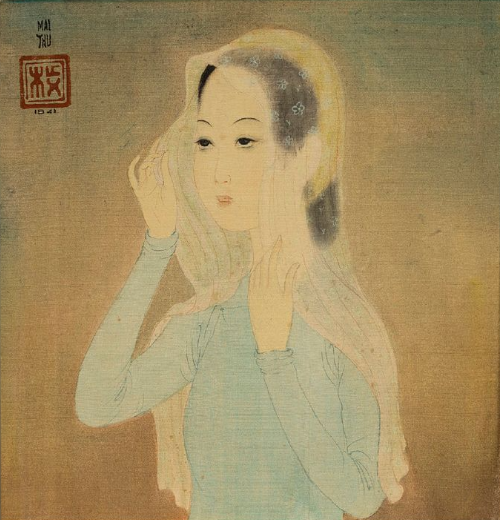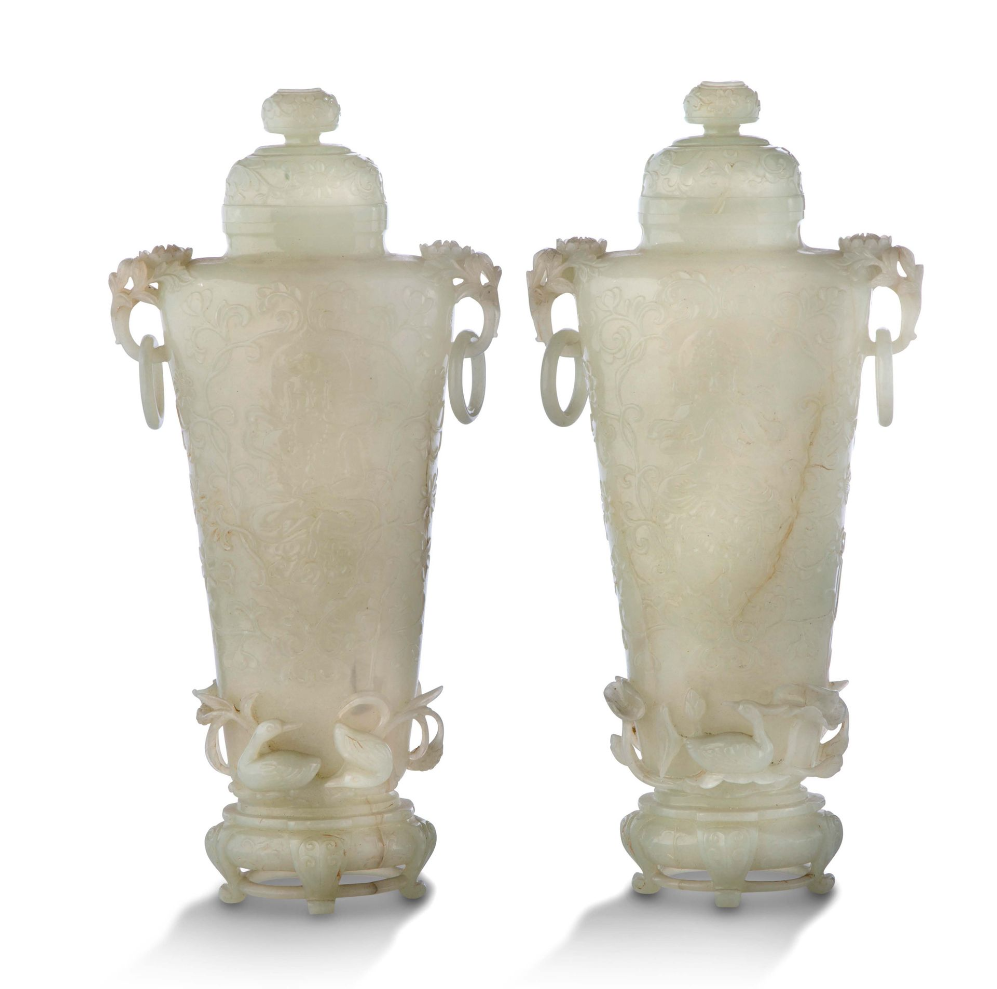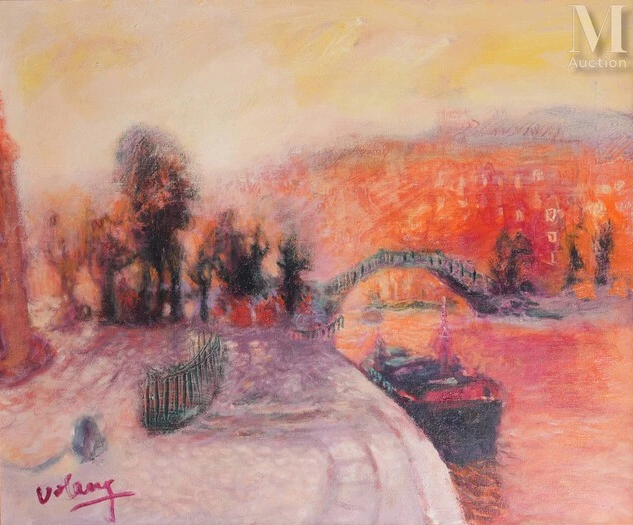A European forerunner in the market for artists from Asia, Aguttes will be holding its new edition of Asian Weeks from September 18 to 27, 2023 in Neuilly-sur-Seine. The Asian Painters, Major Works auction [39] will be held on September 26, 2023, while the Asian Arts auction will take place the following day, September 27, after 8 days of public viewing. An opportunity to discover several centuries of artistic creation in Asia!
If the signatures that punctuate the catalog are familiar to us, each work is unique!—Charlotte Aguttes-Reynier, expert
ASIAN ARTISTS, MAJOR WORKS
Tuesday, September 26, 2023
MAI TRUNG THỨ (1906-1980)
The 38 previous sales organized by Aguttes have shed new light on the work of Mai Trung Thứ, who has long remained confidential. A Vietnamese painter who graduated from Indochina’s École des Beaux-Arts, he then moved to France in the late 1930s. Whether depicting young girls or landscapes, Mai Trung Thứ’s works pay homage to the beauty of Vietnamese women, making them one of the artist’s favorite subjects.
Produced in 1941, Femme au voile fleuri is one of the works from Mai Trung Thứ’s first pictorial period. Using a technique of ink and color successively washed onto silk, the artist depicts an elegant young Vietnamese woman. Although her face is typically Asian, it is individualized. The veil dotted with small flowers completes the model’s elegance. Playing with details and the finesse of her hands, Mai Trung Thứ reveals his talent as a portraitist. Acquired in Paris in the years following its creation, this work has remained in the same family ever since.

MAI TRUNG THỨ (1906-1980)
Femme au voile fleuri, 1941
Ink and colors on silk, signed and dated upper left
29,5×28,5 cm — 11⅝×11¼ in
Provenance: Private collection, Paris (acquired in the 1930s), Then by descent, South of France
A timeless exercise, the depiction of still life allows artists to demonstrate their technical mastery while fostering their creativity. Over the centuries, depictions of apples have been the prerogative of artists such as Giuseppe Ruoppolo, Henri Fantin-Latour and Cézanne, but Mai Trung Thứ is renewing the genre. Drawing on the classic elements that make up a kitchen, he proposes a naturalistic vision: here, he depicts spoiled apples, thus underlining the ephemeral nature of these fruits and recalling the original meaning of the vanitas. The presence of a rice bowl evokes the artist’s origins. Combining a Far Eastern technique with a Western subject, Mai Trung Thứ brings an innovative vision to one of painting’s oldest genres.

MAI TRUNG THỨ (1906-1980)
Nature morte aux pommes, 1959. Ink and colors on silk, signed and dated lower left.
In original frame made by the artist, 38,3×46,1 cm.
Phạm Hậu (1903-1995) or the artistic revival of lacquerware
A key artist and craftsman of twentieth-century Vietnam, Phạm Hậu contributed to the recognition of lacquerware as a true art in its own right, whereas it had long been restricted to handicrafts. A true ambassador of Vietnamese art, the artist notably participated in the revival of lacquer within the Indochina School of Fine Arts, and was behind the country’s first university of applied art, the National School of Handicrafts. Mainly inspired by depictions of landscapes and forests, but also of animals, his lacquers are collected by both European and Vietnamese enthusiasts.
Cho-Bo’s rapids take up a subject dear to the artist’s heart. Inspired by the beauty of his country’s landscapes, Phạm Hậu pays tribute to the lush vegetation and thus recalls the prosperity and natural wealth of his country.
The master lacquerer embellishes the traditional lacquer technique with pillared mother-of-pearl and a rare ultramarine green. Gold highlights evoke the sun shimmering on the rocks, while silver highlights emphasize the foam of the waves. The remarkable work of the artist, thanks to the introduction of new colors and materials, allows us to renew this popular theme. And once again, Pham Hâu sublimates his native country through lacquer.

PHẠM HẬU (1903-1995). Les rapides de Cho-Bo. Lacquer, gold, silver and looted mother-of-pearl highlights signed lower right
99,8×199,4 cm. Provenance: Important collection of a European who lived in Indochina around 1940
Private collection (brought back from Indochina and passed on by descent). Related works:
Phạm Gia Yên, Sơn mài Phạm Hậu, Fine Arts Publishing house, 2019, page 44
Aguttes sale, June 7, 2021, lot 1
Aguttes sale, November 29, 2021, lot 16
Les enfants of Mai Trung Thứ (1909-1980)
This painting charms the viewer with its liveliness and multitude of characters. It is rare in Mai Trung Thứ’s work to find so many individuals in a single painting. Many of Mai Trung Thứ’s compositions feature only a very small number of figures, in a pared-down setting. Here, with characteristic precision, the artist depicts a flock of children with spontaneous attitudes. Bathing, arranging a bed of tulips, fighting or perched on a tree, these children offer a wide variety of expressions. The rhythm of the colors and shapes and their treatment of space enliven this scene with a unique character.

MAI TRUNG THỨ (1906-1980). Les enfants, 1971. Ink and colors on silk, signed and dated lower left. 66,5×94 cm
In original frame made by the artist
LÊ PHỔ (1907-2001), Nature morte aux pivoines et plante en pot, 1935
Created in 1935, Nature morte aux pivoines et plante en pot belongs to his first pictorial period. As his style developed, the artist explored its possibilities. Today, the work stands as a rare testimony to the artist’s early work and explorations in oil painting. Opting for a classical format, Lê Phô perpetuates the still-life tradition. His composition is wise, with peonies and a green plant harmoniously arranged on a table partly covered by a carpet. The perspective is classical and the palette realistic. Following in the footsteps of the old masters, this young Vietnamese artist proves his mastery of the codes of Western painting.

LÊ PHỔ (1907-2001)
Nature morte aux pivoines et plante en pot, 1935
Oil on canvas, signed and dated lower right
65,7×45,3 cm — 25⅞×18 in
Provenance:
Nguyen Sang’s personal collection (received from his father, who had owned it since around 1940 according to family tradition)
Private collection, France (acquired by an art-loving friend in Saigon in the 1980s, brought back to France and kept ever since)
MAI TRUNG THỨ (1906-1980), La ronde des enfants, 1965
Mai Trung Thứ has always been strongly committed to peace and the independence of Vietnam, and it’s with this in mind that he collaborates with Unicef and paints numerous scenes of children’s games to raise awareness among Western audiences. This brought him great notoriety and enabled him to publicize his political and social battles.
The innocence of these characters and their joie de vivre are perfectly represented by the silk painter’s talent, thanks to a confident line and the use of a vivid, shimmering palette.

MAI TRUNG THỨ (1906-1980)
La ronde des enfants, 1965
Ink and colors on silk, signed and dated lower left,
82,3×93,3 cm — 3¼×36¾ in
Provenance:
Private collection, South of France (acquired in 1970 from Galerie de Cannes)
Then by descent, South of France
LƯƠNG XUÂN NHỊ (1914-2006), La récolte
Lương Xuân Nhị, born in Hanoi in 1914, occupies a major place within the Vietnamese artistic sphere of the 20th century. He uses a modernity that gives his production a character all its own.
Through this rural landscape, we perceive the influences of modern Western techniques on the artist’s work. Lương Xuân Nhị plays with light and color. The luminous sky at the end of the day is reflected on the mineral beds of the rice field. In the background, we find the silhouettes of the workers, creating a unity with the landscape. The artist has succeeded in conveying a soft, peaceful atmosphere, characteristic of his pictorial style.

LƯƠNG XUÂN NHỊ (1914-2006)
La récolte
Oil on canvas, signed lower right
46×65 cm — 18⅛×25⅝ inch
Provenance: Private collection, Bretagne
ASIAN ART
Wednesday, September 26, 2023

CHINA, QING DYNASTY, 19th CENTURYH 24 cm
Rare and important pair of celadon nephrite jade covered vases, of elongated form flaring to the shoulder, the base imitating a quadripod pedestal decorated with foliage and ruyi heads. The base is decorated with figures embossed representing three Mandarin ducks frolicking among lotuses and millet stalks. The body is decorated with a dense network of intertwining floral scrolls, and in the center are figures of bodhisattvas, seated on clouds, adorned with floating jewels and ribbons, their hands performing various mudras or holding various attributes. The shoulder is marked and flanked by two handles in the form of blossoming chrysanthemum stems holding mobile rings. The lid is carved with foliage scrolls, and the handle is delicately recessed.

JAPAN, SOTATSU TAWARAYA SCHOOL EDO PERIOD, 17th CENTURY, H. 116 cm. ; L. tot. 337 cm,
PROVENANCE: A copy of the certificate and invoice of purchase from the “Compagnie de la Chine et des Indes”, Paris, in 1989.
Rinpa-style six-leaf folding screen, decorated in ink and colors on gold-flecked buff paper, depicting an imaginary garden with flowers from the four seasons: hydrangeas, poppies, dandelions, clematis, bamboo carnations, peonies, young pine shoots, irises, trifoliate sagittaria… The elegant composition depicts each species in a dense bouquet of harmoniously intertwining flowers and leaves. On the lower right, the circular red “I’nen” seal.
The Rinpa movement was born at the turn of the 17th century, from the collaboration of Tawaraya Sotatsu and Hon’ami Koetsu, erudite aesthetes and multi-talented artists. Deeply influenced by the refinement and elegance of the Heian period (794-1185), considered the quintessence of Japanese artistic expression, they fused existing currents to invent a new decorative style, freed from the constraints of official court art. This new style was an unprecedented artistic upheaval, with a lasting influence on Japanese decorative arts. Rinpa artists freely drew inspiration from the heritage of their predecessors, without direct transmission from master to disciple, giving rise to a multitude of original styles that share a common trait of boldness and freedom in composition, a quest for aestheticism in everyday life through all the mediums of Japanese art (lacquer, ceramics, painting…) and a particular attachment to representations of nature.
Although a leading figure of the Rinpa movement and already recognized as an outstanding artist of his time, Tawaraya Sotatsu remains a mystery, as little is known about his life. He seems to have been active between 1600 and 1640 at the Tawaraya workshop in Kyoto. This decorative workshop (eya), which brought together artists specialized in all kinds of painting-related disciplines (illumination, paper decoration, fan and screen painting, etc.), supplied the aristocracy of the Imperial Court as well as the new class of wealthy merchants.
The composition of the present screen, a rhythmic play of shapes and colors created by the arrangement of flowers in isolated bouquets, is in line with Sotatsu Tawaraya’s scattered compositions of four-season flowers, a specialty of his workshop. In the lower right-hand corner, the circular red “I’nen” seal used by both the master and the Tawaraya workshop can be seen.

CHINA, QING DYNASTY (1644-1911), H. 57 cm,
PROVENANCE: Collection Peltzer de Clermont. Le Neubois – Spa – ventes galeries St Georges – Liège, by reputation (see label below the figure)
Important porcelain pheasant figure with polychrome enamel and gold highlights, the bird shown perched on a rock enameled in pink, blue, green and white coulures, left leg raised, claws folded. The orange-enameled body is punctuated with brushstrokes in imitation of the plumage, the wings folded back, the feathers finely detailed and decorated in a palette of vivid hues (red, green, pink, blue, black, turquoise) with significant gold highlights. The tall, slender neck is treated in a delicate gradation of pink, green, yellow and pale blue, zebra-striped with black. The head, turned to the left, is topped by a crest punctuated with gold motifs, the short beak slightly curved. Inside the rock, a label “Fong-hoang (oiseau sacré de l’Impératrice) chine XVIII. Collection Peltzer de Clermont. Le Neubois – Spa – ventes galeries St Georges – Liège.”.
The pheasant is one of the most frequently depicted birds in classical Chinese art. Its iconography, eminently political, is associated with authority and Mandarin functions. It is thus depicted on the insignia of second- and fifth-rank civil servants. One of its names in Chinese is “changwei zhi”, which plays on the homophony of the words “chang” and “zhi”, both meaning “to regulate” and “for a long time”. The representation of the pheasant is therefore a wish for stable, long-lasting government.
ASIAN PAINTERS, MAJOR WORKS
Expert Asian painters
Charlotte Aguttes-Reynier
+33 1 41 92 06 49 – reynier@aguttes.com
ASIAN ART
Head of Asian Art
Clémentine Guyot
+33 1 47 45 91 54 – guyot@aguttes.com
ASIAN WEEKS
Public exhibition
Monday September 18 to Wednesday September 27: 10am – 1pm and 2pm – 5:30pm (except weekends)
Source: Aguttes







